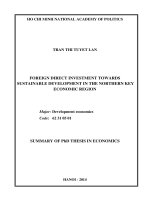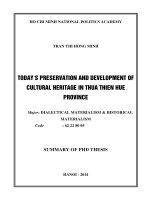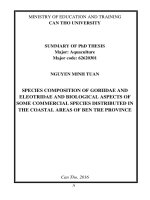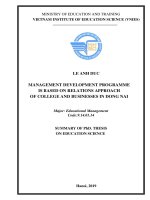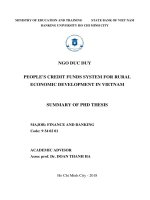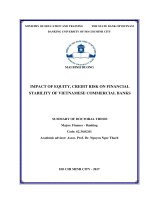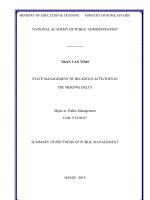Summary of PHD thesis: People''s credit funds system for rural economic development in Vietnam
Bạn đang xem bản rút gọn của tài liệu. Xem và tải ngay bản đầy đủ của tài liệu tại đây (400.2 KB, 25 trang )
MINISTRY OF EDUCATION AND TRAINING
STATE BANK OF VIET NAM
BANKING UNIVERSITY HO CHI MINH CITY
NGO DUC DUY
PEOPLE'S CREDIT FUNDS SYSTEM FOR RURAL
ECONOMIC DEVELOPMENT IN VIETNAM
SUMMARY OF PHD THESIS
MAJOR: FINANCE AND BANKING
Code: 9 34 02 01
ACADEMIC ADVISOR
Assoc prof. Dr. DOAN THANH HA
Ho Chi Minh City - 2018
1
INTRODUCTION
1. Abstract
The operation of the People's Credit Fund (PCF) system is also facing
difficulties and challenges on the way of sustainable development.
Especially in the context of small-scale PCF, they have to compete with
other types of credit institutions. The PCF system can only overcome the
difficulties and challenges when overcoming the weaknesses and
promoting the advantages of the cooperative type of credit, especially the
ability to associate in organization and operation. Between the units
forming the PCF system. However, this is one of the weaknesses of the
organization and operation of the PCF system has not been completed.
With the aim of providing solutions to improve the system of PCF
with rural economic development, the author has selected the topic "The
People's Credit Funds system with rural economic development in
Vietnam".
2. Overview research
Domestic research, Foreign research.
The gap of research and research direction of the thesis:
There are many research projects on the PCF system, but the
operation of the PCF system after the restructuring phase of credit
institutions for the period 2011-2015 and preparation for the second
phase from 2015-2018 there are many changes. Therefore, research on
the operation of the PCF system in this time domain is necessary and
there is no overlap with the research works of which the author is known.
So far none of the research works that the author is known is: assessment
of the impact of activities of the PCF system to rural economic
development.
3.
Research objectives
2
General objective of the thesis: Proposed solutions to improve the
operation of the PCF system contributing to rural economic development
in Vietnam.
4.
Object and scope of the research
4.1. Research subjects
The People's Credit Funds system (Activities of the PCF system is
regulated in Circular No. 04/2015 / Circular - State bank on People's
Credit Funds).
4.2. Research scope
Scope of research space: The People's Credit Funds system in
Vietnam.
Range of research time:
The data for the analysis of the real situation of the operation PCF
system in Vietnam is collected in 2010-2017.
The data for use in the model of factor assessment on the operation of
the PCF system is collected from 2015-2016.
The data for use in the credit assessment model of PCF system to the
living standards of the rural population is collected through the Vietnam
household living standards survey 2012, 2014.
5.
Methodologies
Methodology: The thesis utilizes dialectical materialism.
Research methodology: The thesis is based on statistical survey
method, method of analysis, comparison, inductive, synthetic ...
6.
New contribution of the thesis
New contributions in theory:
The thesis has provided an overview of the PCF system such as: the
concept of the PCF system, the activities of the PCF component
constituents, the factors affecting the operation of the PCF system.
3
The thesis has set out the criteria for assessing the performance of the
PCF system, the relationship between the completion of the operation of
the PCR system and rural economic development.
New contributions in practice:
The access to credit of PCF helped increase the living standard of the
household to 393,000 VND / person / month and increased living
expenses of the household to 290,000 VND / person / month, equivalent
to 20%. As a result, credit of PCF contributed significantly to improving
the living standards of households.
The impact of credit by PCF system and credit on other financial
institutions on the living standards of the rural population is the same in
both places, having an impact on increasing household living expenses.
Chapter 1
RATIONALES ON PERFECT OPERATION OF THE
PEOPLE 'S CREDIT FUND SYSTEM AND
RURAL ECONOMIC DEVELOPMENT
1.1. Overview of the operation of the People's Credit Fund system
1.1.1. Common problems
1.1.1.1. Concept of the People's Credit Fund system
According to the Decree No. 48/2001 /Decree - Government dated
13/8/2001 on organization and operation of PCF and Circular No.
04/2015 / Circular - State bank, the concept of PCF is as follows: is a
type of credit institutions that co-operates on the principle of
voluntariness, self-control, self-responsibility for performance results, the
main objective being mutual support among members in order to
promote the collective strength and of each members help each other to
4
effectively carry out production activities, business services and improve
living.
1.1.1.2. The organizational structure of the people's credit fund system
- Platforms: The foundation of the PCF system is composed of PCFs.
- Link development department.
1.1.2. Operation of the People's Credit Fund system
1.1.2.1. The basic units constituting the system of people's credit funds
- Operation of grassroots people's credit funds.
- Activities of the credit institutions.
- Operations of the coordinating system.
1.1.2.2. Factors affecting the operation of the People's Credit Fund
system
Internal Factors, External Factors.
1.2. To improve the operation of the People's Credit Fund system
with rural economic development
1.2.1. To complete the operation of the People's Credit Fund system
1.2.1.1. Viewpoints to complete the operation of the People's Credit Fund
system
Completing the operation of the PCF system must be a regular and
continuous process in order to overcome the shortcomings and help the
PCF system develop safely and effectively.
1.2.1.2. The necessity of improving the operation of the People's Credit
Fund system
Derived from the orientation of the Party and State; Derived from the
need to improve the quality and effectiveness of the operation of the PCF
system.
5
1.2.1.3. Indicators assessing the level of performance of the People's
Credit Funds system
The quality of lending operation; Products and services; Financial
capacity; Yielding; Operational risk; Applying information technology in
the operation of the PCF system.
1.2.2. The relationship between the completion of the operation of the
People's Credit Fund system and rural economic development
1.2.2.1. The role of improving the operation of the People's Credit Fund
system with rural economic development
Improving the operation of the PCF system is a factor and plays an
important role in the socio-economic development process in rural areas.
In essence, the PCF system has a financial and social role.
1.2.2.2. A model assessing the impact of the activities of the People's
Credit Fund system on rural economic development
The development of the rural economy is expressed in many aspects,
namely, the level of poverty reduction, income generation, employment,
development of rural transport infrastructure, increased access to
financial services health, education ... In this reseach, the author focuses
on the performance of rural economic development as the living standard
of rural people when using credit services of PCF system.
1.3. Foreign experience in organization and operation of the People's
Credit Funds system and lessons for Vietnam
1.3.1. Foreign experience
Desjardins Credit Fund, Quesbec - Canada, German Federal Bank.
1.3.2.Some lessons for Vietnam
6
Firstly, the PCF system should improve autonomy, self-responsibility
and promote the spirit of mutual aid between the constituent units of the
system;
Secondly, the Safety Fund is one of the decisive factors for
strengthening and consolidating weak public health workers;
Thirdly, the training of human resources is considered as the decisive
factor for success of the PCF system.
Fourthly, the Cooperative Bank must always carry out the role of
regulating capital, ensuring the liquidity of the PCF in a quick and
flexible manner and meeting the demand for loans of grassroots PCF.
Chapter 2
ACTUAL OPERATION OF THE PEOPLE'S CREDIT FUND
SYSTEM WITH RURAL ECONOMIC DEVELOPMENT IN
VIETNAM
2.1. Introduction of the People's Credit Fund system in Vietnam
2.1.1. History formation and development of the People's Credit Fund
system in Vietnam
Pilot period of establishment (1993- 2000), consolidation and
reorganization phase (01 / 2001-6 / 2004), completion and development
phase (7/ 2005- now).
2.1.2. Opportunities and challenges in the operation of the People's
Credit Fund system in Vietnam
7
Firstly, the Party and State are increasingly interested in the collective
sector in general, the PCF system in particular and the conditions for this
model to develop.
Secondly, with the policy of attaching importance to the three
agricultural policies (Agriculture - Rural - Farmers), the Party and State
always pay attention and mobilize all resources for agricultural and rural
development in the direction of industrialization and modernization.
Thirdly, the results and achievements gained recently have made
people more confident and active participation in the PCF system. This is
one of the most favorable factors for PCF to scale up and improve the
quality operations.
Challenges:
Firstly, the chartered capital of PCF is still low, so the level of capital
mobilization and lending is limited.
Secondly, the credit market in rural areas is at risk of being left empty.
Thirdly, the most PCF have had computers for accounting and debt
management, but transactions have not yet been transferred between the
Cooperative bank and grassroots PCF.
2.1.3. The operation of the units constituting the People's Credit Fund
system in Vietnam
2.1.3.1. Cooperative Bank
• Capital mobilization:
Continuing to promote the operation of the Central People's Credit
Fund, capital mobilization operation of the Cooperative Bank have a
tendency to increase. In 2010, the bank will raise its charter capital to
4,320 billion VND and 2,670 billion VND in 2017.
8
• Credit operatio:
The Cooperative Bank provides loans to support and improve the
performance of the grassroots PCF. In addition, the Cooperative Bank
provides loans to other entities on a priority basis to meet the demand for
reasonable loans from grassroots PCF.
• Capital operation:
The regulatory capital in the PCF system through the central role of
the Cooperative Bank increased from 2010 to 2017, especially in the two
years 2011 - 2012 the amount of regulated capital reached the highest
level of 610 billion in 2012 because these two years it is also a difficult
time for the whole banking system in Vietnam.
• Payment and treasury services: Account opening; Payment and
treasury services; Other operation.
2.1.3.2. Grassroots People's Credit Fund
• Capital mobilization:
The average growth rate of capital mobilized from grassroots PCF
level from 2010 to 2017 is very good, from 6,028 billion VND in 2016 to
18.02 billion VND in 2017, which is an increase of 2.98 times. Very
impressive for grassroots PCF.
• Credit operatio:
Average outstanding loans / grassroots PCF from 2010 to 2017
increased quite fast, from 10,060 billion VND in 2010 to 16,250 billion
VND in 2017, increase of approximately 1.6 times.
Other
operatio:
Open
deposit
account;
Payment
Procurement of fixed assets; Other professional operatio.
2.1.3.3. Vietnam Association of People's Credit Fund
services;
9
Consultancy
operatio;
Training
operatio;
Information
and
communication operatio; Foreign affairs.
2.1.4. Analyzing the factors affecting the operation of the People's
Credit Fund system in Vietnam
Size: 300
Participants: people working at People's Credit Funds
Scale and structure of the questionnaire: The scales used in the
reseach are the likert scale with the following five common scales: very
disagree, disagree, normal, agree, very agree.
Data Analysis: Descriptive statistics of demographic variables; factor
analysis; correlation analysis, regression analysis.
Official reseach results:
Rating scale reliability - Cronbach's Alpha coefficient: Cronbach's
Alpha coefficient ranges from 0.863 to 0.894.
EFA Discovery Factor Analysis:
The coefficient of KMO is 0.881> 0.5 and Sig = 0.000 <0.05,
assuming that correlations between observed variables are correlated in
overall.
The coefficient of KMO is 0.797> 0.5 and Sig = 0.000 <0.05 should
assume that the correlation between the dependent variables is correlated
in the overall.
Correlation between factors: Between the independent variables and
the dependent variable, the correlation coefficient has a non-zero value,
and the corresponding Sig value equals 0.000, which is very small
compared to 0.05. Assertions between independent variables and
10
dependent variables are linearly correlated with the correlation
coefficient here, namely the Pearson Correlation coefficient, derived
from the correlation matrix.
Results of the regression function:
PCF = 0.184 * Human resources of the PCF system + 0.164 *
Information technology + 0.124 * Financial capacity + 0.116 *
Ownership and operation + 0.116 * Network system + 0.116 * Risk
management capacity + 0.087 * Operational strategy + 0.069 * Products
and services.
2.2. The situation of completing the operation of the People's Credit
Fund system in Vietnam
2.2.1. To complete the operation of the people's credit fund system
according to the evaluation criteria
2.2.1.1. Quality of lending activities
According to the Cooperative Bank report, by the end of 2017, nearly
1,205 PCF mobilized over 82,000 billion VND and lent 76,000 billion
VND, providing loans to around 8-9 million people. Unlike banks, PCF
are only operated locally, mobilized from local members, and are lent
only to those members. As a result, credit funds have a clear grasp of
borrowers, with the lowest NPL ratio in the system ranging from 1% to
2%.
2.2.1.2. Service products
The products of PCF have not really linked to the demand of
customers, which is very clear in the situation of overcapacity which is
happening in PCF while many rural households are still in shortage of
11
capital for production to trade, or to access credit in other lending
channels.
2.2.1.3. Financial capacity
Operational sustainability (OSS): OSS in the period 2007-2015 is
more than 100%, considered to be sustainable in terms of operations.
However, international practice suggests that OSS should be greater than
120% for long-term sustainability.
Financial Self-Sustainability (FSS): FSS of PCF in the period 2007 2015 is over 100%, which demonstrates the ability of financial
intermediaries to secure their financial self-sufficiency.
2.2.1.4. Yielding
According to the State Bank in Vietnam, by the end of 2017, the has
2050 of PCF system operating in 57 provinces and cities with the total
assets of more than 100,000 billion VND. Among types of credit
institutions, the models of profitability leading the PCF system, higher
than commercial banks. For the period 2007-2015, ROA and ROE of
credit funds were always higher than the industry average, respectively
0.49% and 5, respectively. 49%.
2.2.1.5. Operational risk
Over the past time, the State Bank has discovered about 30 credit
funds across the country with a scale of several hundred billion, by 3
individuals contributed capital, then lending to large enterprises. Some
PCF have not followed up their operation objectives, show signs of profit
and do not strictly follow the credit process, so there are always many
risks in operation, threatening the safety of the PCF system.
12
2.2.1.6. Applying information technology in the operation of the people's
credit fund system
In some PCF, staffs and staffs have been regularly focused on
upgrading the professional qualifications and skills of the staffs and
building a prestigious, friendly, convenient, safe and efficient unit.
2.2.2. Analyzing the impacts of the People's Credit funds system on
rural economic development
(1) Research methodology: The main method is quantitative method.
Use the DID method to assess the impact of credit on PCF on the living
standards of people rural in Vietnam.
Combination of Differential Difference (DID) with OLS regression
To assess the impact of credit of PCF on living standards of rural
population, the topic uses DID method, in which credit of creditors'
credit is considered as a policy variable. The topic was randomly selected
from two groups of households in accordance with the DID
methodology. Group 1, referred to as the participating group, consists of
local households participating in PCF borrowing within one year of the
Vietnam Household Living Standards Survey in 2014 and does not
borrow in the Level Survey Households Vietnam in 2012. Group 2,
referred to as the comparison group, is the non-borrowing household in
both surveys.
(2) Research model
Yit = β0 +β1D+β2T+β3D*T+β4Zit + εit
Yit is the indicator reflecting the living standard of household i at time t.
13
D = 1: surveyed households belong to the participating group; = 0:
Survey households belong to comparison group. T = 0: Household
survey in 2012; = 1: Households surveyed in 2014.
Zit is the control variable: it consists of variable groups that reflect
demographic
characteristics,
characteristics
of
education
and
employment, household production capacity, etc.
+ Households in the comparison group in 2012 have D = 1 and T = 0, so
the standard of living is: E (Y00) = β0 + β4Zit
+ Households in the group in 2012 have D = 1, T = 0, so the standard of
living is: E (Y10) = β0 + β1 + β4Zit
The difference in living standards between the two household
groups in 2012 is: E (Y10) - E (Y00) = β1
+ Households in the comparison group, in 2012 have D = 0, T = 1, so the
standard of living is: E (Y01) = β0 + β1 + β4Zit
+ Households belonging to the participating group in 2014 have D = 1, T
= 1, so the standard of living is: E (Y11) = β0 + β1 + β2 + β3 + β4Zn.
=> The difference in living standards between the two groups of
households in 2014 is: E (Y11) - (Y01) = β1 + β3.
=> The impact of credit of PCFs on the living standards of the rural
population is: = {E(Y11) –E(Y01 )} –{E(Y10) – E(Y00)} = β3 = DID.
(3) Describe the variables in the model
Dependent variable: Per capita income and living expenses per capita
in real terms represent the living standard of the rural population.
Independent variables:
Table 2.1. Describe independent variables
Symbol
Define
Unit
Expected
mark
14
CREDIT
T
T*CREDIT
HHSIZE
DEPRATE
HEADAGE
HEADMALE
ETHNIC
AVERHHEDU
NONFARMINC
LANDPERCA
NORTH
SOUTH
DISTANCE
PP CREDIT FUND
CREDIT OF PP CRE FUND
OTHER FIN INS
CREDIT OF OTHER FIN INS
CAREER
Turns dummy into a household group, = 0
if the household is in a comparative group
(no loan), = 1 if the household is a
participant (loan).
Turns the dummy to the time of the
survey, = 0 if the survey time is 2012, = 1
if it is 2014.
The interaction between household groups
and time, the coefficient of estimation for
this variable is the effect of credit on
income or household expenditures.
Household size, The number of household
members.
Household dependency ratio, equal to the
number of dependents per worker.
Age of household head.
Sex of household head, = 1 if head is male,
= 0 if head is female.
Ethnicity of the head of household, = 1 if
being Kinh or Hoa, = 0 if other ethnic
group.
The average education level of the
household is equal to the average number
of schooling years per household member.
The ratio of non-farm income to total
income.
Area of cultivated land per capita.
+
+
People
-
People
-
Age
+
+
Year
+
%
+
2
+
M
In the North, = 1 if the household is in the
North, = 0 if the household is in another
region.
South, = 1 if the household is in the south, = 0
if the household is in another area.
Distance from home to center.
PCF
+/-
Credit PCF
Other Financial Institutions.
+
+
Credit Other Financial Institutions.
+
Career.
+
+
+
+
(4) Describe the data
The topic uses the data of the two VHLSSs in 2012 and 2014. VHLSS
2012 surveyed income and expenditure on 9,300 households and the
VHLSS for 2014 surveyed income and expenditure on 9,280 households.
Of these, 4,250 households participated in both surveys. Because
sampling of these two standard living ques- tions is randomly selected,
15
the sampling requirement of the DID method is to ensure randomness.
With a sample size of 217 * 2 = 434 observations were filtered out from
two sets of data. The reseach selected 113 local households in 2014 not
participating in PCF in the 2012 VHLSS and borrowed funds from PCF
in the VHLSS 2014 as a participating group, and 104 households in 2014
but did not participate in the loan. The capital of PCF in both surveys is
similar to that of households with loans for comparison. Assuming that in
2012, these two groups have the same starting point, if the two groups do
not have loans from PCF, their income and expenditures will vary from
2012 to 2014.
(5) Research results
• Impact of the PCF on household income
Table 2.2. Credit impact of PCF on income
Dependent Variable: average income, VND/ People/ Month
Regression result 1:
Variable
T*CREDIT
CREDIT
T
C
R-squared
Adjusted R-squared
S.E. of regression
Sum squared resid
Log likelihood
F-statistic
Prob(F-statistic)
Prob(Wald F-statistic)
Coefficient
Std. Error
t-Statistic
Prob.
65063.47
4476.085
40044.16
185704.4
53842.42
11681.30
48071.39
7362.957
1.208406
0.383184
0.833014
25.22144
0.0276
0.7018
0.4053
0.0000
0.065168
0.058646
134530.3
7.78E+12
-5739.152
9.991879
0.000002
0.000333
Mean dependent var
S.D. dependent var
Akaike info criterion
Schwarz criterion
Hannan-Quinn criter.
Durbin-Watson stat
Wald F-statistic
199127.0
138657.6
26.46614
26.50368
26.48096
1.149819
6.323630
Regression result 2: Add other control variables to the model
Variable
Coefficient
Std. Error
t-Statistic
Prob.
16
CREDIT
T
T*CREDIT
HHSIZE
AVERHHEDU
NONFARMINC
ETHNIC
SOUTH
HEADMALE
LANDPERCA
DEPRATE
HEADAGE
C
27658.94
18899.11
66842.84
-13160.70
16507.59
247454.5
-38703.72
-8511.482
8685.879
0.601798
25105.45
133.0229
50249.10
R-squared
Adjusted R-squared
S.E. of regression
Sum squared resid
Log likelihood
F-statistic
Prob(F-statistic)
Prob(Wald F-statistic)
0.587404
0.575644
90325.18
3.43E+12
-5561.668
49.94743
0.000000
0.000000
10696.28
35504.02
35855.31
2683.758
2428.292
67887.85
8867.488
9197.379
8454.686
4.233224
16477.68
287.1757
22672.22
2.585846
0.532309
1.864238
-4.903832
6.798024
3.645048
4.364677
-0.925425
1.027345
0.142161
1.523603
0.463211
2.216329
Mean dependent var
S.D. dependent var
Akaike info criterion
Schwarz criterion
Hannan-Quinn criter.
Durbin-Watson stat
Wald F-statistic
0.0100
0.5948
0.0630
0.0000
0.0000
0.0003
0.4533
0.3553
0.3048
0.8870
0.0284
0.6435
0.0272
199127.0
138657.6
25.68972
25.81172
25.73787
1.805444
21.33926
Source: From research results of the author
The impact of the People's Credit Fund system on spend
Table 2.3: Credit impact of PCF on spend
Dependent Variable: average spend, VND/ People/ Month
Regression result 1:
Variable
Coefficient
Std. Error
t-Statistic
Prob.
CREDIT
T
T*CREDIT
C
11902.50
22579.46
60928.45
41431.20
5711.966
21692.09
25731.87
4736.391
2.083783
1.040908
2.367821
8.747421
0.3378
0.2985
0.0183
0.0000
R-squared
Adjusted R-squared
S.E. of regression
0.073207
0.066741
64720.68
Mean dependent var
S.D. dependent var
Akaike info criterion
40295.35
66994.93
25.00272
17
Sum squared resid
Log likelihood
F-statistic
Prob(F-statistic)
Prob(Wald F-statistic)
1.80E+12
-5421.591
11.32182
0.000000
0.011679
Schwarz criterion
Hannan-Quinn criter.
Durbin-Watson stat
Wald F-statistic
25.04026
25.01754
1.684603
3.712587
Regression result 2: : HET adjustment results (variance of change
error)
Dependent Variable: Average spend
Method: Least Squares
Sample: 1 434
Included observations: 434
Variable
Coefficient
Std. Error
t-Statistic
Prob.
T
CREDIT
T*CREDIT
HHSIZE
42356.72
16070.43
64705.11
-8149.203
17260.48
5574.035
18886.77
1606.506
2.453971
2.883089
3.425948
-5.072625
0.0545
0.0641
0.0007
0.0000
AVERHHEDU
HEADAGE
HEADMALE
NONFARMINC
DEPRATE
LANDPERCA
ETHNIC
NORTH
SOUTH
C
34.91924
15.42633
406.9993
55741.87
-28297.32
0.996329
5447.749
36222.78
-6404.872
37942.02
1505.463
153.0796
5737.601
34509.43
19239.74
2.283603
7003.423
13700.31
5036.590
16013.68
0.023195
0.100773
0.070935
1.615265
-1.470775
0.436297
0.777870
2.643938
-1.271668
2.369350
0.0215
0.0698
0.0435
0.1070
0.0421
0.6628
0.0371
0.0085
0.2042
0.0183
R-squared
Adjusted R-squared
S.E. of regression
Sum squared resid
Log likelihood
F-statistic
Prob(F-statistic)
Prob(Wald F-statistic)
0.313500
0.292251
56361.38
1.33E+12
-5356.464
14.75375
0.000000
0.000000
Mean dependent var
S.D. dependent var
Akaike info criterion
Schwarz criterion
Hannan-Quinn criter.
Durbin-Watson stat
Wald F-statistic
Source: From research results of the author
40295.35
66994.93
24.74868
24.88007
24.80054
1.924012
5.964090
18
• Comparing the impact of PCF and other credit on household living
standards.
Table 2.4. Impact of PCF and other credit on income and spend
Dependent Variable: Average income, VND/ People/ Month
Variable
Coefficient
Std. Error
t-Statistic
Prob.
T
CREDIT OF PP CRE FUND
OTHER CREDIT
T* CREDIT OF PP CRE FUND
T* OTHER CREDIT
HHSIZE
AVERHHEDU
DEPRATE
NONFARMINC
CAREER
DISTANCE
LANDPERCA
C
-278.7451
-19065.77
91410.10
47676.12
4850.654
4911.867
10090.44
-22101.14
-8657.294
179655.1
9000.834
20.86626
-39605.14
12372.74
9473.496
17848.01
26000.94
22207.36
2044.487
2375.421
12102.13
9631.507
8332.737
1165.932
7.068888
14960.78
-0.022529
-2.012538
5.121584
1.833631
0.218426
2.402493
4.247853
-1.826218
-0.898851
21.56015
7.719864
2.951845
-2.647264
0.9820
0.0448
0.0000
0.0674
0.8272
0.0167
0.0000
0.0685
0.3692
0.0000
0.0000
0.0033
0.0084
R-squared
Adjusted R-squared
S.E. of regression
Sum squared resid
Log likelihood
F-statistic
Prob(F-statistic)
Prob(Wald F-statistic)
0.754478
0.747479
69677.39
2.04E+12
-5449.028
107.8093
0.000000
0.000000
Mean dependent var
S.D. dependent var
Akaike info criterion
Schwarz criterion
Hannan-Quinn criter.
Durbin-Watson stat
Wald F-statistic
199127.0
138657.6
25.17064
25.29264
25.21879
1.527772
114.8167
Table 2.5. Impact of PCF and credit of other financial institutions on
household expend
Dependent Variable: Average spend, VND/ People/ Month.
Variable
T
OTHER CREDIT
T* OTHER CREDIT
Coefficient
Std. Error
t-Statistic
Prob.
-6815.381
-12135.18
47203.44
5219.474
12552.43
38590.10
-1.305760
-0.966760
1.223201
0.1924
0.3342
0.0219
19
T* CREDIT OF PP CRE FUND
HHSIZE
HEADAGE
HEADMALE
AVERHHEDU
ETHNIC
DEPRATE
NONFARMINC
SOUTH
CAREER
DISTANCE
CREDIT OF PP CRE FUND
LANDPERCA
C
18226.60
-6099.484
852.6608
9089.907
5575.393
921.9185
-31782.99
11784.51
10798.97
735.2632
6427.674
14578.89
-7.972444
52802.91
R-squared
Adjusted R-squared
S.E. of regression
Sum squared resid
Log likelihood
F-statistic
Prob(F-statistic)
Prob(Wald F-statistic)
0.329868
0.304156
55885.34
1.30E+12
-5351.227
12.82911
0.000000
0.000000
16201.81
4480.250
389.6852
5770.843
1362.033
6656.277
20343.54
11757.42
7982.217
8714.436
1299.096
9949.325
3.970335
13221.61
1.124973
-1.361416
2.188076
1.575144
4.093435
0.138504
-1.562314
1.002304
1.352879
0.084373
4.947806
1.465314
-2.008003
3.993683
Mean dependent var
S.D. dependent var
Akaike info criterion
Schwarz criterion
Hannan-Quinn criter.
Durbin-Watson stat
Wald F-statistic
0.0612
0.0741
0.0292
0.0160
0.0001
0.0899
0.0190
0.3168
0.0768
0.9328
0.0000
0.1436
0.0453
0.0001
40295.35
66994.93
24.73837
24.89792
24.80135
1.866973
12.94555
Note: - Credit of PCF = 1 if the household does not borrow money from PCF in 2012 and borrowed
in 2014, = 0 if the household did not borrow in both periods. Credit from other sources = 1 if the
household does not borrow money from another financial institution in 2012 and borrows in 2014, =
0 if the household does not borrow at both.
Source: From research results of the author
2.3. Assessment of the current situation of improving the operation
of the People's Credit Fund system for rural economic development
in Vietnam
2.3.1. These achievements
First: PCF operate effectively, contributing significantly to the socioeconomic development, improving the living conditions of members and
especially the development of rural agriculture.
20
Second: Vietnam Association of PCF has initially performed some
basic tasks.
Third: Credit quality is improved, overdue debts are always allowed
by the State Bank, ensuring the safety of loans.
Fourth: Products and services are increasingly focused on quality,
meet the diverse needs of customers, especially the loan service more
flexible, suitable for rural economic characteristics.
Fifth: the financial capability of the PCF system has been
strengthened and strengthened to meet the demand of PCF operation.
Sixth: The profitability of the PCF system is increasing, as compared
to commercial banks, the scale of operation of the PCF system is smaller,
the number of loans is smaller, the bad debt ratio is lower than the ROA
and ROE higher than Commercial banks. This shows the good
performance of PCF.
Seventh: Credits of PCF have an impact on increasing the real income
of the household. The access to credit of PCF helped increase the living
standard of the household achieved 393,000 VND / person / month.
2.4.2. Limitations and reasons
Firstly: The self-financing capital of grassroots PCF is still limited.
Second: Credit quality is uneven.
Third: Some grassroots PCF have expanded their scope, geographical
area and scale of operation beyond management capacity.
Fourth: The implementation of the financial and accounting regime
and safety of treasury of some grassroots PCF is not serious.
Fifth: the regulation of available capital in the PCF system has not
met the demand of PCF.
21
Sixth: The Cooperative Bank has not implemented the function of
supporting grassroots PCF for the period 2010 - 2017.
Seventh: Autonomy and self-responsibility of the PCF system have
not been properly promoted.
Eighth: the PCF system has not yet established preventive
mechanisms and effective measures to promptly respond to grassroots
PCF.
Nineth: the link between PCF is still in form, not in essence.
Chapter 3
SOLUTIONS FOR OPERATION OF THE PEOPLE 'S CREDIT
FUNDS SYSTEM RURAL ECONOMIC DEVELOPMENT IN
VIETNAM
3.1. Development orientation of the People's Credit Funds system
inVietnam until 2020
- General direction.
- Orientations for completing the operation of the People's Credit
Fund system in Vietnam.
3.2. Solutions to improve the operation of the People's Credit Funds
system to contribute to rural economic development in Vietnam
3.2.1. Solutions to complete the operation of the units constituting of
the People's Credit Fund system in Vietnam
3.2.1.1. For grassroots People's Credit Funds
It is necessary to improve the quality of human resources in terms of
professional and professional ethics in order to meet the requirements of
work in the new situation.
22
To enhance the quality and efficiency of the board of supervisors'
activities in order to detect, warn and promptly present shortcomings and
risks of violating the law on organization and operation.
Need to diversify the list of products and services.
Strengthening the financial capacity of grassroots PCF.
3.2.1.2. Cooperative Banks
To improve the professional procedures and procedures and apply
new technologies in order to raise the efficiency of the operation of
regulating the capital available to the grassroots PCF; improve the ability
to serve, support the grassroots PCF; Strengthening of co-financing
activities between Cooperative Banks and grassroots PCF.
3.2.2. Solutions to complete activities of the People's Credit Fund
system to rural economic development in Vietnam
3.2.2.1. Improve the quality of loans at People's Credit Funds
It is necessary to diversify the loan portfolio to minimize credit risk:
PCF need to do well in mobilizing capital, creating the foundation for
credit expansion; It is necessary to do well the marketing work of
People's Credit Funds.
3.2.2.2. Develop a specific activity strategy for each stage
Funds need to develop a phased strategy: Define strategic objectives
for each stage; An analysis of the external environmental factors that
indicates the opportunities and challenges for the fund's objectives;
Analysis and assessment of the elements of the funds themselves; Reevaluate the fund's strategic objectives; Developing the appropriate
strategies, selecting the best strategy for execution, that is corresponding
to the objective, combining the actual conditions inside and outside each
23
credit fund will have specific strategies. Since each fund has different
conditions, the strategies selected are different.
3.2.2.3. Perfecting the products and services of People's Credit Funds
PCF need to design products and policies that are tailored to the needs
and characteristics of rural households.
3.2.2.4. To enhance the financial capacity of the people's credit fund
system
PCF should have policies to attract idle capital in the population
through attractive promotions and interest rates.
Some PCF have poor financial capacity so they can merge with other
PCF to strengthen their financial capacity and conduct the merger in line
with Cooperative Banks regulations.
3.2.2.5. To control the operation risks of people's credit funds
Improve the effectiveness of risk identification, assessment and
management; Strengthen effective control activities; Building effective
information and communication systems.
3.2.2.6. To enhance the application of information technology to the
operation of the people's credit fund system
The application of information technology in the care and customer
service of the fund will be better than the current mode of
communication: Reduce transaction costs, shorten the loan evaluation
period, the professional the business is carried out quickly, accurately
and ensure the security and safety.
3.2.2.7. Improve the quality of human resources of the People's Credit
Fund system
24
Facilitate employees to participate in professional training programs
that improve their professional knowledge and understanding of financial
services.
3.2.2.8. To raise the level of impact of the operation of the people's credit
fund system to rural economic development in Vietnam
Develop a friendly PCF system for rural people by simplifying
lending procedures.
Implement the interest rate policy in rural areas in accordance with
the market mechanism, gradually remove preferential interest rates.
3.2.3. Some recommendations
For local authorities.
For the State Bank from central to local.
